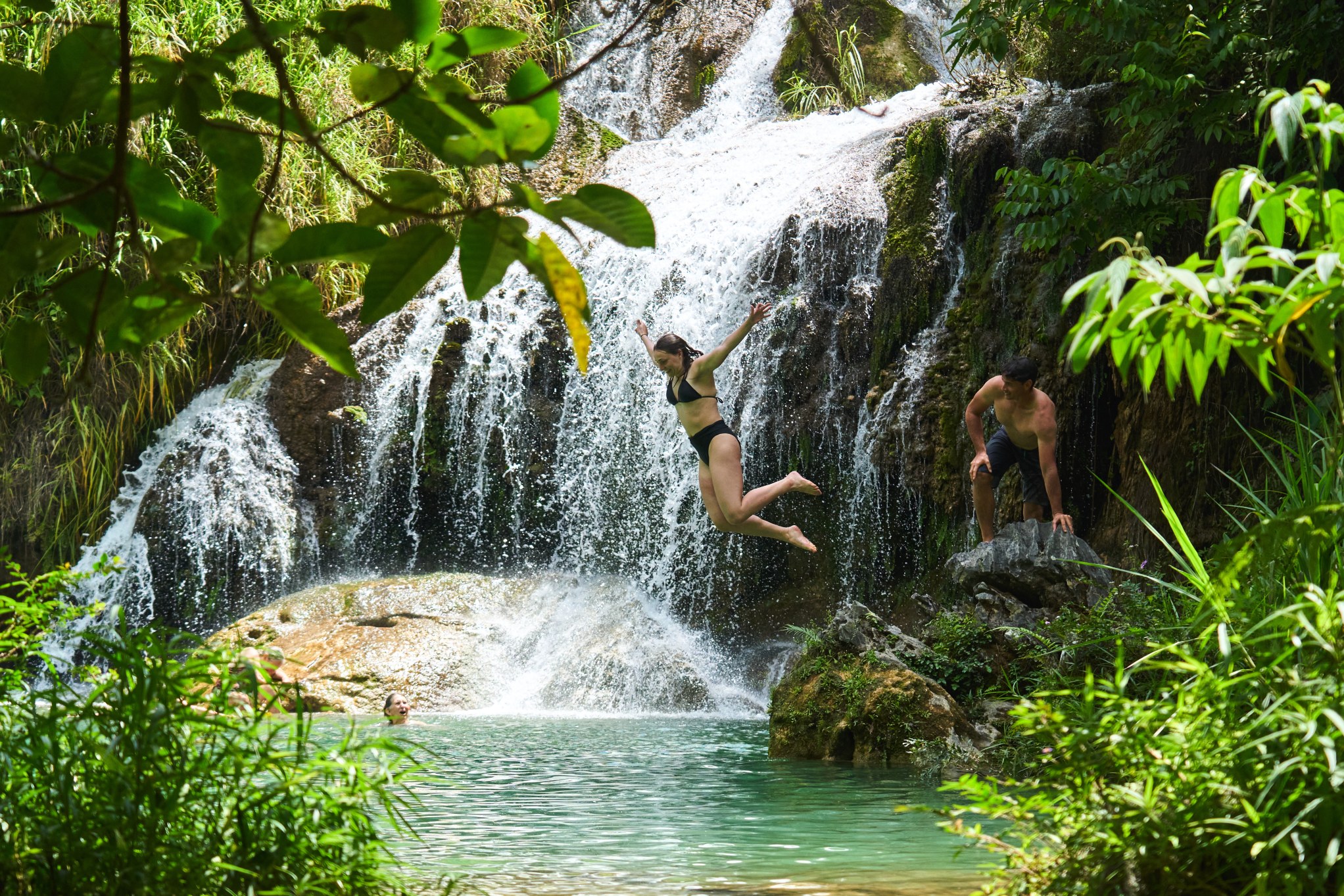HOW TO GET TO CUBA
Cuba is an unforgettable destination—but for American travelers, it does require some advance planning. Fortunately, it’s entirely legal to visit Cuba under one of 12 approved travel categories. This trip qualifies under the Support for the Cuban People category, which emphasizes authentic engagement through stays in guesthouses, meals at local restaurants (paladares), and interactions with small Cuban businesses.
Flights to Havana
To get to Cuba, most major U.S. airlines offer direct flights to Havana (Airport Code: HAV), where this trip starts and ends. You'll need a Cuban Tourist Card (visa), which can usually be purchased through your airline or at the airport before departure. Additionally, U.S. travelers must obtain Cuban health insurance, often included in the cost of your airline ticket.
To check for the best value and routes of flights, we suggest using Google Flights. Google Flights compares all of the different airline websites in one place and lets you book with the airlines directly. Never book through a third party and always book through the airline so you have ownership of your ticket. Remember to plan your activities to align with the approved travel category and keep a record of your itinerary and receipts for at least five years as required by U.S. regulations. Following these guidelines, you can enjoy an unforgettable journey exploring Cuba’s vibrant culture and warm hospitality.
Flight Booking Details: Travelers are required to book their own flights to and from Havana (HAV). If you would like assistance with flight booking (for a fee), you can contact Laura Marchese at Travel Central: Laura Marchese at Travel Central.
Visa & Entry Requirements
As of August 2024, all travelers flying to Cuba from the U.S. must obtain an electronic visa (eVisa). This replaces the pink paper tourist card (also called a visa or entry permit). The eVisa and tourist card are the same thing, just in digital format.
✅ What You’ll Need to Enter Cuba:
-
Cuba eVisa (required for all U.S. departures)
-
General License Affidavit (required by U.S. law)
-
Valid Passport (must be valid for at least 6 months beyond your trip)
-
Proof of Travel Medical Insurance (included in most U.S.-to-Cuba flights)
-
Address for Your First Night in Cuba (we’ll send this 10 days before your trip)
-
Completed D’Viajeros Immigration Form + QR Code (required at check-in)
💻 How to Get Your Cuba eVisa:
Option 1: Cuban Adventures (Easy & Fast)
Buy the eVisa when booking your tour or as a standalone item. Receive your eVisa and D’Viajeros link via email within 1–3 days. Payment via credit card.
Option 2: Cuban Embassy (Cheaper, Less Convenient)
-
Complete the form on Cuba’s official eVisa site
-
Mail a USPS money order for $50 made out to:
Embassy of Cuba in Washington D.C., U.S.A
-
Mail to: 2630 16th St NW, Washington, D.C. 20009
-
Once processed, you’ll receive your eVisa and D’Viajeros link
-
Contact: [email protected] | Phone: 202-797-8520
Option 3: Airport (Emergency Use Only)
Available at Miami and Houston airports via Cuba Travel Services (CTS). If you haven’t purchased in advance, staff at the airline gates can help.
⚠️ Not recommended—only use if you’re in a pinch. Cost is $85–$100 depending on the airline.
Arrival and Departure Accommodation in Havana
The first and last nights of your Cuba trip will be spent in guesthouse accommodations, ideally located in Old Havana, Central Havana, or Vedado.
-
Arrival and Departure Transfers: We’ve got your airport transfers covered! You'll be picked up from the Havana airport (or any other location in Havana if you're already in Cuba) and taken directly to your joining guesthouse.
-
Late or Early Arrivals/Departures: If you’re arriving late or departing early, don’t worry! We can help arrange for you to catch up with the group or assist with early departure arrangements. Additional transport costs may apply for these adjustments.
ULTIMATE CUBA TRAVEL CHECKLIST
Here’s everything you need to prepare before takeoff:
-
✈️ Return/onward flight confirmation (required to enter Cuba)
-
🏠 Address of first night’s accommodation (provided 10 days before trip)
-
🛂 Valid passport (must be valid 6+ months beyond your travel dates)
-
💻 Cuba eVisa
-
💡 General License Affidavit (for U.S. travelers)
-
💊 Prescription & non-prescription medication (bring all you may need)
-
📄 Proof of travel medical insurance
-
📱 D’Viajeros customs/immigration QR code (fill out within 7 days of arrival on the D'Viajeros website)
-
💵 Enough cash for your entire trip (USD or Euros) - more information found here
-
💳 Credit card (for emergencies only—U.S. cards rarely work in Cuba)
-
☀️ Sun protection (hat, sunglasses, sunscreen)
-
🔦 Power outage items: headlamp, portable charger, battery fan, mosquito repellent with DEET
-
🌱 Reusables to reduce plastic: refillable water bottle, cloth tote, reusable straw
Currency
Cuba uses the Cuban Peso (CUP). U.S. dollars are not widely accepted, and American credit or debit cards are generally not functional in Cuba. It's advisable to bring enough cash in U.S. dollars or euros, which can be exchanged for Cuban Pesos upon arrival. Euros often receive a better exchange rate than U.S. dollars, which are subject to a conversion fee.
Currency exchange can be done at official CADECA offices, banks, or some hotels. Avoid exchanging money on the street, as this can be risky. For most purchases, you’ll rely on cash, but a few tourist spots may accept euros or dollars directly.
ATMs and Banking: ATMs are scarce, and international cards can be limited in their usability. It's wise to plan ahead and exchange currency before you arrive. Avoid relying on ATMs to withdraw cash once you're there.
Spending Money
We estimate each traveler will need between $450 and $600 USD for local expenses, including meals and optional activities during your time in Cuba.
Electrical Plugs and WiFi
Cuba uses 110V and 220V electricity, with Type A, B, or C outlets. Many accommodations have dual voltage, but it’s a good idea to check ahead and bring a voltage converter if needed. If you have a three-pronged plug (common in the U.S.), be sure to bring an adapter, as many Cuban outlets are two-pronged.
Wi-Fi in Cuba is limited and generally slower than what you might be used to. Access is available in some hotels, guesthouses, and public Wi-Fi hotspots, but speeds can vary. To use public Wi-Fi, you’ll need an ETECSA Wi-Fi card, which can be purchased in hotels, at ETECSA offices, or from vendors on the street.
Prepare for a slower, more disconnected experience—it’s the perfect opportunity to unplug and immerse yourself in Cuba’s vibrant culture!
Tipping
Your local guides are already compensated, but it's customary to budget at least $100.00 USD for tips during your trip. This money will be distributed to our hardworking local guides, who help ensure you have an unforgettable experience.
Weather and What to Wear
March is one of the best times to visit Cuba. Expect warm, pleasant weather with daytime temperatures between 77°F to 85°F (25°C to 29°C) and cooler evenings around 65°F (18°C). Rain is minimal, making it perfect for exploring the vibrant cities and picturesque landscapes.
Pack lightweight, breathable clothing (cotton or linen) for the day and a light jacket or sweater for cooler evenings. Comfortable walking shoes are essential, especially for exploring the cobblestone streets of Havana and other historic areas. Don’t forget sunscreen, a wide-brimmed hat, and sunglasses to protect against the tropical sun.
Check out recommended travel accessories here to help you prepare for your Cuban adventure!
Dining
Cuban cuisine is a vibrant fusion of Spanish, African, and Caribbean influences. Dishes like ropa vieja (shredded beef), arroz con pollo (chicken and rice), and tostones (fried plantains) offer a true taste of the island. You’ll find meals at paladares (private restaurants) and casas particulares (guesthouses) where home-cooked meals feature fresh local ingredients.
Don't miss out on the delicious street food, including empanadas and sugarcane juice. Pair these with a refreshing mojito, guarapo, or a rich Cuban coffee.
Cultural Events & Festivals
-
Carnival in Santiago de Cuba: While Havana's carnival is later in the year, Santiago de Cuba (on the southeastern side of the island) celebrates a vibrant carnival in March. If you're interested in experiencing Cuban culture and lively street parades, consider visiting this part of Cuba.
-
Music and Arts: March also features various music and arts events in Havana. Cuba is known for its jazz and classical music, so you might find performances at places like the National Theatre or cultural centers in Havana.
Transportation and Security
Local Transportation: While public transportation in Cuba is available, it can be unreliable. Taxis and private car rentals are widely available but may be more expensive than you expect. Consider using a private driver for more comfort and flexibility.
Bicycles and Walking: Havana and many Cuban cities are relatively small and walkable, so renting a bike or simply walking around can be a great way to explore.
Cuba is one of the safest countries in Latin America, with violent crime being rare. However, petty theft can happen, so be cautious and keep your belongings secure, especially in crowded areas. Stick to official taxis and avoid unlicensed ones.
Local Customs: Cubans are friendly and welcoming to tourists. Be respectful of local traditions, especially regarding politics. Avoid discussing sensitive political topics, as these can be considered controversial.
Introduction, History, and Geography
Cuba is the largest island in the Caribbean, known for its vibrant culture, colonial architecture, classic cars, and rhythmic music. With a rich history shaped by Spanish and African influences, it offers travelers a unique blend of tradition and natural beauty.
Cuba's history is fascinating, from its indigenous roots to Spanish colonization, and the Cuban Revolution of 1959. Today, the island’s colonial cities and revolutionary monuments tell the story of Cuba's resilient identity.
Cuba's geography is diverse, with beaches, lush valleys, and tobacco fields. Must-visit spots include Viñales Valley, the Sierra Maestra mountains, and historic cities like Havana, Trinidad, and Santiago de Cuba. With its tropical climate, Cuba is a year-round destination for nature lovers and beachgoers alike!
Travel Insurance
Travel insurance is strongly recommended to protect against unforeseen circumstances that could impact your trip, such as cancellations, medical emergencies, or lost luggage. We advise all travelers to purchase a comprehensive travel insurance policy that covers both medical expenses and trip interruptions. For more information on travel insurance options, you can check out You Can't Steal My Happy's Travel Insurance Page.
Terms and Conditions
Before booking your trip, please review the terms and conditions associated with this trip. By participating, you acknowledge that you understand and agree to these terms. For full details, please refer to You Can't Steal My Happy's Terms and Conditions.
Happy Commandments
As part of your journey, we encourage you to embrace the values and principles that ensure a positive and enriching travel experience. These guiding principles are designed to help you make the most out of your adventure. Please review and embrace the 10 Commandments of You Can't Steal My Happy.















































